First living being was a plant
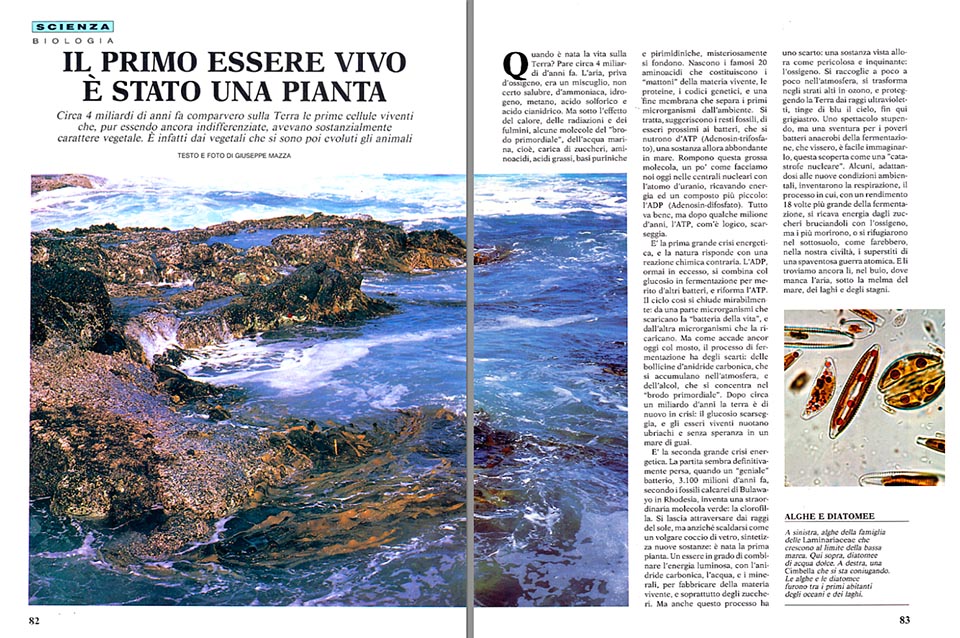
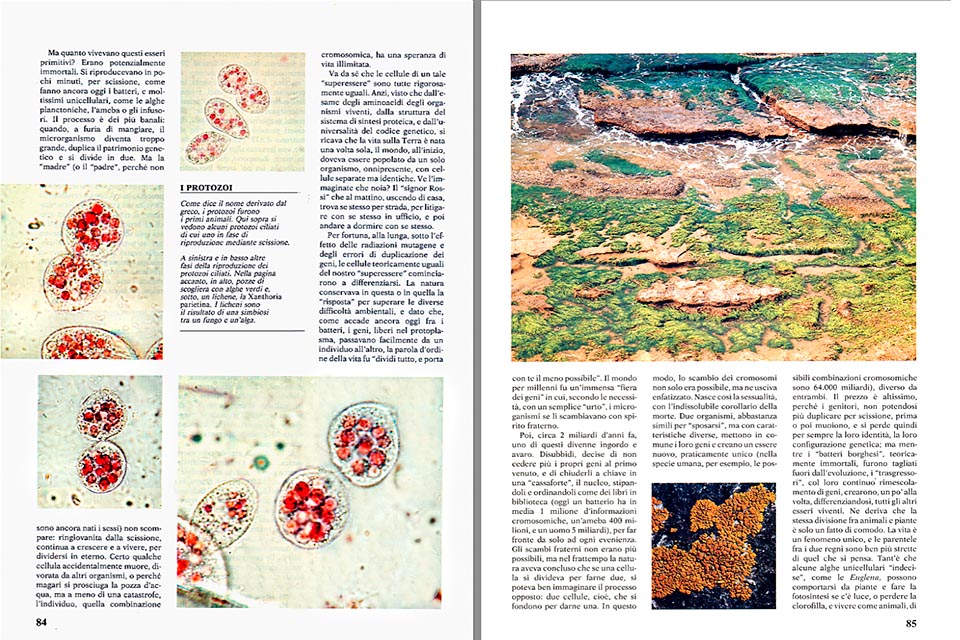
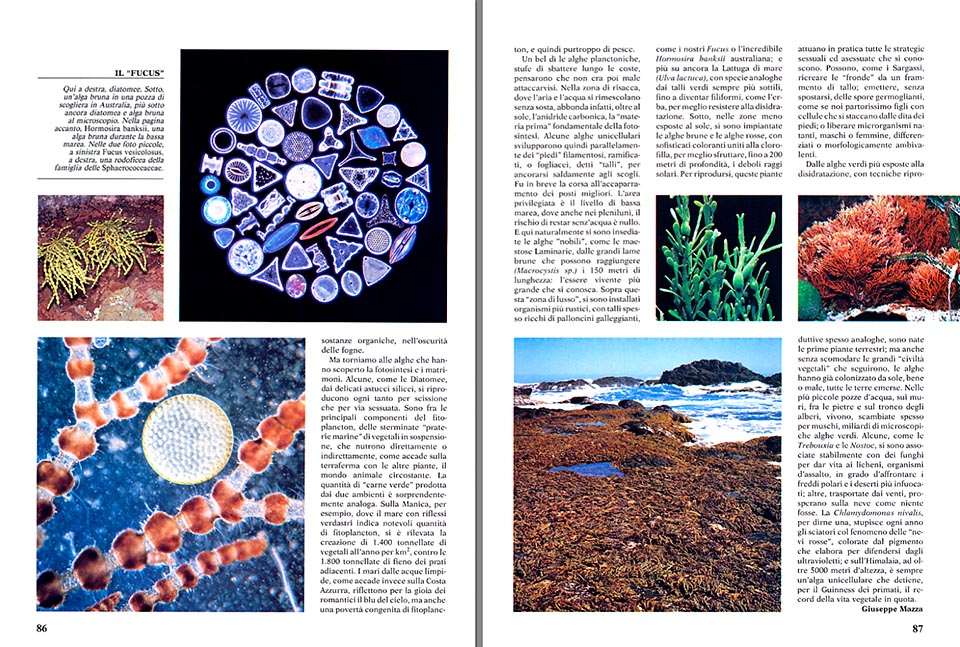

Texto © Giuseppe Mazza

English translation by Mario Beltramini
When was born the life on the earth?
It seems, about four billions of years ago. The air, without oxygen, was a mixture, unhealthy, by sure, of ammonia, hydrogen, methane, sulphuric and hydro cyanic acids. But, under the effect of the heat, the radiations, and the lightnings, some molecules of the “primordial soup”, that is, of the sea water, full of sugars, amino acids, fatty acids, purine and pyrimidine bases, mysteriously, melt.
In this way, come to life the famous twenty amino acids which constitute the “bricks” of the living matter, the proteins, the genetic codes, and a thin membrane which separates the first micro-organism from the environment.
It is matter, as fossilized remains suggest, of beings similar to the bacteria, which feed on ATP (Adenosine triphosphate), a substance at that time abundant in the sea. They break this great molecule, something as we do now in the nuclear plants with the atom of uranium, getting energy, and a smaller compound: the ADP (Adenosine diphosphate). All proceeds well, but, after some millions of years, the ATP, logically, begins to be short.
It’s the first great energy crisis, and the nature answers back with a contrary chemical reaction. The ADP, which is now in excess, combines with the fermenting glucose thanks to other bacteria, and forms again the ATP. In this way, the cycle is wonderfully closed: on one side, micro-organisms which discharge the “battery of the life”, and on the other, micro – organisms which recharge same.
But, as it happens also nowadays with the must, the process of fermentation has some refuses: small bubbles of carbon dioxide, which accumulate in the atmosphere, and alcohol, which concentrates in the “primordial soup”.
After about one billion of years, the earth is again in crisis: the glucose is lacking, and the living beings, swim, drunk, and hopeless, in a sea of troubles.
This is the second great energy crisis. The game looks definitely lost, when a brilliant “bacterium”, 3.100 millions of years ago, after the calcareous fossils of Bulawayo in Rhodesia, invents an extraordinary green molecule: the chlorophyll. This allows the rays of the sun to pass through it, but, instead of warming up, like any common fragment of glass, synthesizes, in a still nowadays mysterious way, the corporeal and the immaterial.
The first plant comes out. A being able to combine the light energy, with carbon dioxide, water, and minerals, to fabricate some living matter, and, above all, sugars.
But also this process has a refuse: a substance which at that time was considered dangerous and polluting: the oxygen.
It gathers, slowly, in the atmosphere, it transforms, in the upper strata, in ozone, and, while protecting the earth from the ultraviolet rays, dyes in blue, the sky, until that time greyish. A wonderful view, but a misfortune for the poor anaerobic bacteria
of the fermentation, which lived, it’s easy to imagine, this discovery as a sort of “nuclear catastrophe”.
Some of them, adapting to the new environmental conditions, invented the respiration, the process where, with an output 18 times greater than the fermentation, they could draw out energy from the sugars, burning these ones with the oxygen, but most of them passed away, or took shelter underground, just as would do, in our civilization, the survivors to a terrible atomic war. And we can still find them there, in the darkness, where air is lacking, under the mud of the sea, lakes and ponds.
But, how long did they live, these primitive beings?
Potentially, they ware immortal. They reproduced in few minutes, by scission, as do, also now, the bacteria, and many unicellular beings, such as the plankton algae, the amoebae, or the infusorians.
The process is quite banal: when, by dint of eating, the micro – organism becomes too big, it duplicates the genetic patrimony and splits in two. But the “mother” (or the “father”, as the sexes were not yet born!), does not disappear: rejuvenated by the scission, it goes on in growing and living, to split itself for ever.
Certainly, some cells, fortuitously, die, eaten by other organisms, or because, the puddle dries up, but, unless a catastrophe happens, the individual, that chromosome combination, has an unlimited expectation of life.
Needless to say, the cells of this “super-being”, are all strictly alike. On the contrary, seen that from the examination of the amino acids of the living organisms (always the same, moreover, always “L”-shaped), from the structure of the system of protein synthesis, and from the universality of the genetic code, we deduct that the life on earth was born only once, the world, at the beginning, had to be populated by a sole organism, omnipresent, with separate, but identical cells.
Can you imagine what a nuisance? The “Mr. Smith”, who, in the morning, getting out from home, meets himself on the street, then disputes with himself in office, and then goes to sleep with himself!
Luckily, at length, under the effect of the mutation radiations, and the genes duplication errors, the cells, theoretically alike, of our “super-being”, began to differentiate.
The nature was keeping in this or that the “answer” to overcome the various environmental difficulties, and seen that, as still now happens for the bacteria, the genes, free in the protoplasm, were passing easily from an individual to the other, long time before of Franciscans, the password of the life was “share everything and take with you the least as possible”.
The world, for millennia, was an immense “festival of the genes”, where, in accordance to the needs, with a simple “impact”, the micro-organisms exchanged them with a fraternal spirit.
Then, about 2 billions of years ago, one of these became greedy and stingy. He disobeyed, decided not to give its genes to the first comer, and to lock them in a “safe”, the nucleus, ranging them and putting them in order like books in a library (each bacterium has an average of 1 million of chromosomal informations, an amoeba 400 millions, and a human being 5 billions!), to face any event by itself.
Fraternal exchanges were no more possible, but in the meantime the nature had concluded that if a cell divided to get two, then it could well be imagined a contrary proceeding: that is, two cells which merge to form one.
In this way, the exchange of chromosomes, of the “recipes of life”, was not only possible, but it was getting emphasized.
Sexuality was born, with its indissoluble corollary: the death.
Two organisms, sufficiently similar to “get married”, but with different characteristics, put in common their genes, and create a new being, practically unique (in the human species, for instance, the possible combinations of chromosomes are 64.000 billions!), different from both of them.
The price is very high, because the parents, cannot any more duplicate by scission, and, sooner or later, will die, and therefore their genetic configuration is lost for ever; but while the “conventional bacteria”, theoretically immortal, were excluded from the evolution, the “transgressors”, with their continuous mixing up of genes, created, a little at a time, differentiating, all other living beings.
It results, then, that even the division between plants and animals is only a matter of convenience.
Life is a unique phenomenon, and the relationships between the two kingdoms are much closer than what is believed. In fact, some unicellular algae, “irresolute”, such as the Euglena, can behave as plants and effect the photosynthesis if there is light, or lose the chlorophyll, and live, like animals, of organic substances, in the darkness of the sewers.
But, let’s go back to the algae which have discovered the photosynthesis and the marriages. Some of them, such as the Diatoms, with delicate siliceous containers, reproduce nowadays either by division or by sexual way. They are the most important component of the phytoplankton, the endless “sea meadows” of vegetables in suspension, which nourish, directly or indirectly, as it happens in the mainland wit the other plants, the surrounding animal world.
The quantity of “green meat” produced by the two environments is surprisingly similar. In the Channel, for instance, where the sea with greenish reflexes indicates huge quantities of phytoplankton, it has been noted the creation of 1.400 Tons per year of vegetables per square Kilometre, against the 1.800 Tons of hay in the adjacent meadows.
The seas with clear waters, as it happens instead in the Côte d’Azur, reflect, for the joy of romantics, the blue of the sky, but also a congenital scarcity of phytoplankton, and therefore, unluckily, of fish.
But on a nice day the plankton algae, tired of dashing against the costs, thought well that it should not be a bad thing to stick to them.
In the area of surf, where air and water mix incessantly, beyond the sun, there is plenty, in fact, of carbon dioxide, the basic “raw material” of the photosynthesis.
Some unicellular algae then developed some filamentous, ramiform or leafy “feet”, called “thalluses”, in order to cling finally to the rocks. It was, in brief, the rush for gaining the best places.
The preferred area is the line of the low tide, where also during the full moons, the risk of remaining without water does not exist. And here, of course, the “noble” algae have settled, like the solemn Laminariae, with their great brown laminae, which can reach (Macrocystis sp.), the 150 metres of length: the biggest living being known.
Above this “luxury area”, more rustic organisms have settled, with thalluses often rich of floating small balls, like our Fucus or the incredible Australian Hormosira banksii, and more over, the Sea Lettuce (Ulva lactuca), with analogous species with green thalluses more and more thin, till when they become thread-like, as grass, for resisting better to the dehydration.
Below, in the areas less exposed to the sun, have settled the Brown algae and the Red ones, with sophisticated colouring substances, united to the chlorophyll, for exploiting better, till 200 metres of depth, the weak sun rays.
For reproducing, these plants practically put in effect all the sexual and asexual known strategies.
They can, like the Gulf weeds, recreate the “leafy branches” from a fragment of thallus; emit, without getting married, germinating spores, like if we should give birth to children which come off from our toes; or free swimming micro-organisms, male or female, differentiated of morphologically ambivalent, which court, and after a real ballet, melt to create an egg.
From the green algae more exposed to the dehydration, with reproductive techniques often similar, were born the first terrestrial plants; but also without bothering the great “vegetable civilizations”, which came later, the algae have already colonized, by themselves, well or badly, all emerged land.
In the smallest puddles, on the walls, between the stones and on the trunks of the trees, live, often mistaken with fungi, billions of microscopic green algae. Some of them, such as the Trebouxia and the Nostoc, have associated permanently with some fungi, thus giving birth to the lichens, stormy organisms, able to face the polar cold weathers, and the hottest deserts; others, carried by the winds, thrive, even on the snow, without any problem.
The Chlamydomonas nivalis, just to name one, astonishes every year the skiers, with the phenomenon of the “red snows”, coloured by the pigment it elaborates as a defence against ultraviolet rays; and in the Himalayas, at more than 5.000 metres of altitude, it’s always an algae which holds, for the Guinness Book of records, the absolute record of the vegetable life in height.
Plants conquered the dry land
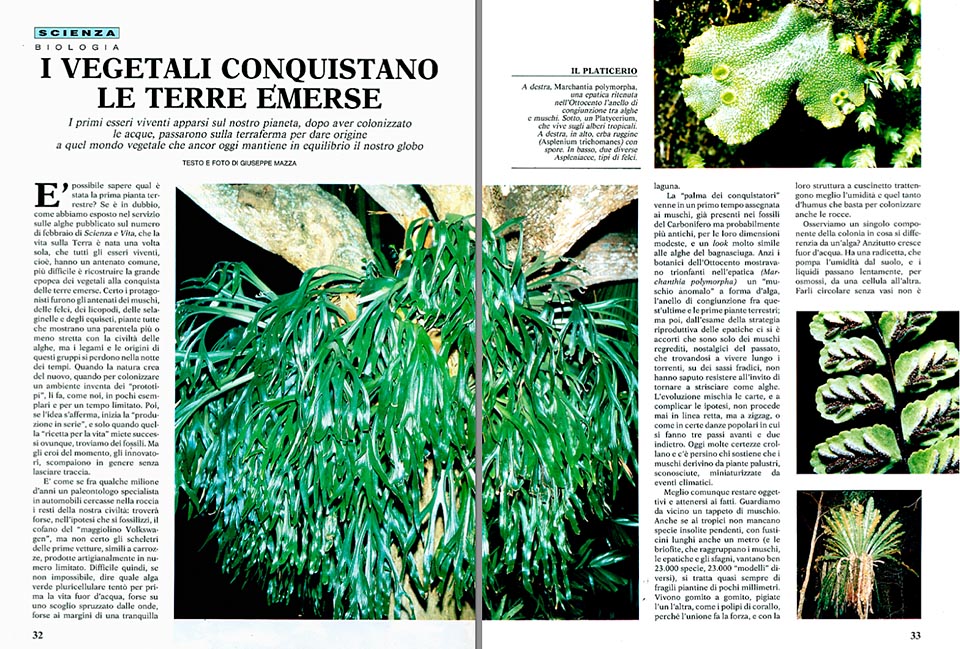
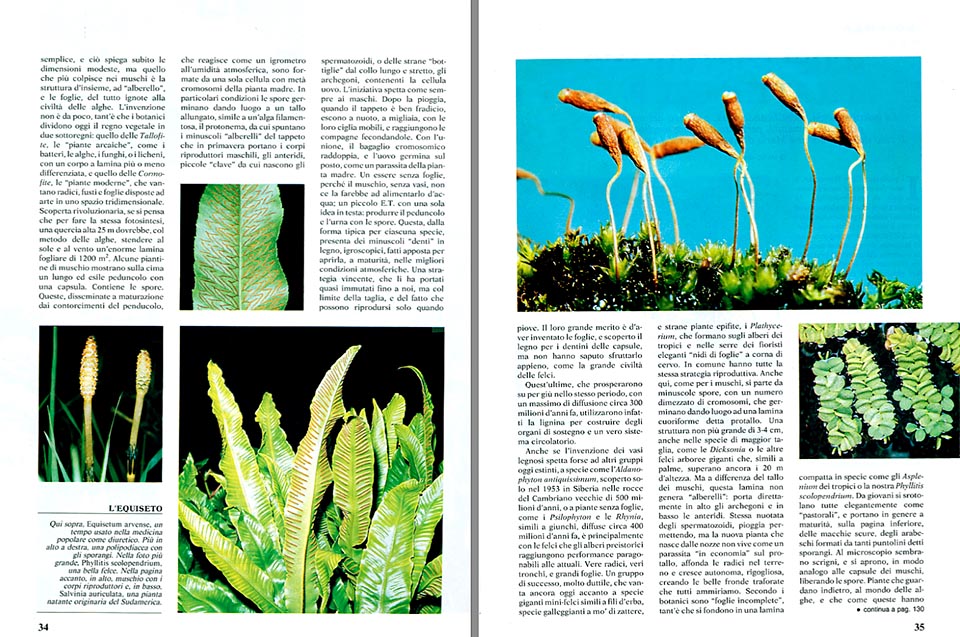
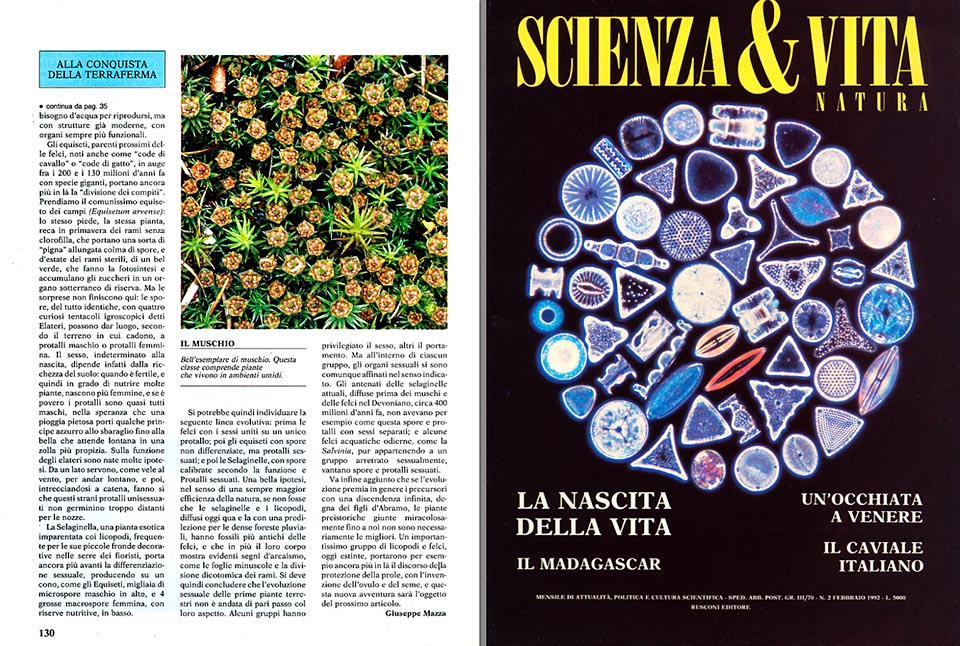

Texto © Giuseppe Mazza

English translation by Mario Beltramini
Which has been the first plant on earth?
Who can say this? If it is sure, as we have told in the article on the algae, that the life on earth was born only once, so that all living beings have a common ancestor, it is more difficult to reconstruct the great epic of the vegetables conquering the emerged lands.
By sure, the protagonists were the forefathers of the mosses, the ferns, the lycopods, the selaginellas, and the horsetails, all plants which show a more or less close relationship with the civilization of the algae, but the bonds and the origins of these groups get lost in the night of times.
When nature creates something new, when for colonizing an environment, it invents some “prototypes”, it makes them, as we do, in few specimen and for a limited time. Then, if the idea is good, it starts the mass production, and only when that “recipe for the life” meets with success everywhere, we can find some fossils.
But the heroes of the moment, the innovators, normally disappear without leaving any trace. It’s something like if, in some million years, a paleontologist specialized in cars, should look, in the rocks, for the remains of our civilization; he would find, maybe, in the hypothesis that it fossilizes, the bonnet of a “beetle Volkswagen”, but not, by sure, the frameworks of the first coaches, similar to carriages, produced by artisans in a limited quantity. Difficult, therefore, if not impossible, to say which green pluricellular alga tried for the first time the life out of water, perhaps on a rock sprayed by the waves, maybe on the borders of a peaceful lagoon.
The “palm of the conquerors” was in a first time granted to the mosses, already present in the Carboniferous, but probably older, due to their modest dimensions, and a look very similar to the weeds of the water’s edge.
Also the botanists of the nineteenth century were showing, triumphant, in the Hepatics (Marchantia polymorpha), an “anomalous moss”, with the form of an alga, the ring of junction between these last and the first earth plants; but later, through the exam of the reproductive strategy of the hepatics, they realized that they are only regressed mosses, nostalgic of the past, which, finding themselves living along the streams, on very wet stones, have not been able to resist to the invitation to resume crawling as the algae.
The evolution shuffles the cards; and, to complicate the hypotheses, never proceeds on a straight line, but moves with zigzags, or like certain folk dances where the do three steps ahead and two back. Today many certainties collapse and there is even who maintains that the mosses come from marsh plants, unknown, which have been reduced to very small dimensions by climatic events.
Better, in any case, to remain objective and to stick to the deeds. Let us look closer at an extent of moss. Even if in the Tropics are present unusual hanging species, with small stalks, long even one metre, and the Bryophytes, which group the mosses, the hepatics, and the bog mosses, count 23.000 species, 23.000 different “models”, it is matter almost always of frail small plants of few millimetres. They live side by side, pressed one against the other, like the polyps of coral on the reefs, because union means strength, and with their structure, similar to a small cushion, they keep better the humidity and the quantity of humus sufficient to colonize even the most inhospitable rocks.
Let us examine a single member of the colony. In what does it differentiate from an alga?
First of all, it grows out of the water. It has a small root, which pumps up the humidity from the ground, and the liquids pass slowly, by osmosis, from a cell to another. To have them circulating without vessels is not simple, and this explains at once the modest dimensions, but what strikes more in the mosses, is the structure of the whole, like a sapling, and the leaves, which are absolutely unknown in the civilization of the algae.
This invention is important, so much that the botanist split, nowadays, the Vegetable Kingdom in two sub kingdoms: that of the Thallophytes, the “archaic plants”, like bacteria, algae, fungi, or lichens, with a more or less differentiated laminar body, and the one of the Cormophytes, the “modern plants”, which have roots, stems, and leaves disposed skilfully, in a tridimensional space.
Revolutionary discovery, if we think that for realizing the same photosynthesis, an oak tall 25 metres should, with the method of the algae, expose to the sun and the wind an enormous foliar lamina of 1.200 square metres.
Some small plants of moss show on the top a long and slim peduncle with a capsule. It contains the spores. These ones, disseminated when ripe, by the contortions of the peduncle, which reacts like a hygrometer to the atmospheric humidity, are formed by only one cell with half of the chromosomes of the mother plant.
In particular conditions, the spores germinate originating a prolonged thallus, similar to a filamentous alga, the Protonema, from where come out the small “saplings”, of the extent, which, in spring, carry the masculine reproducing bodies, the Antheridia, small “clubs”, from which come out the spermatozoa or odd “bottles”, with a long and narrow neck, and the Archegonia, which contain the egg cell.
The initiative is up to the males, as always. After the rain, when the moss is very wet, they get out, swimming, by thousands, with their mobile cilia, and reach their mate, fecundating it.
With the union, the chromosomal patrimony doubles, and the egg germinates on the spot, like a parasite of the mother plant. A being without leaves, as the moss, without pots, is not able to nourish it with water; a little E.T. with only one idea in its head: to produce the peduncle and the urn with the spores. This, with a typical form for each species, presents small “teeth” in wood, hygroscopic, specially done to open it, when ripe, in the best atmospheric conditions.
A winning strategy, which has brought them to us, almost unchanged, but with the limits of the size, and of the fact that they can reproduce only when it’s raining.
Their great merit is of having invented the leaves, and discovered the wood for the small teeth of the capsules, but they have been unable to exploit it fully, as the great civilization of the ferns has done.
These last ones, which thrived more or less in the same period, with a maximum diffusion about 300 millions of years ago, did utilize, in fact, the lignite to construct the sustaining organs and a real circulatory system: pipes which transport the water from the ground to the leaves and feed of sweet sap all the various organs of the plant.
Even if the invention of the woody vessels maybe is due to other groups, nowadays extinct, to species like the Aldanophyton antiquissimum, discovered in 1953 in Siberia, in 500 million years old Cambrian rocks, or to leafless plants, such as the Psilophyton and the Rhynia, resembling to rushes, widespread about 400 millions of years ago, it is mainly with the ferns that the prehistoric trees reach performances comparable to the present ones.
Real roots, real trunks, and large leaves. A successful group, very adaptable, which holds, even nowadays, close to giant species, mini-ferns similar to blades of grass, species which float like rafts, and odd epiphytic plants, the Platycerium, which form, on the tropical trees and in the florists’ greenhouses, elegant “nests of leaves”, with the shape of antlers of a deer.
All of them share the same reproductive strategy.
Also here, as for mosses, we start from small spores, with a halved number of chromosomes, which germinate originating a heart-shaped lamina called Prothallus. A structure not greater than 3-4 cm., even on the species of major height, such as the Dicksonia, or the other giant arboreal ferns, which, similar to palm trees, are more than 20 metres tall.
But, unlike the thallus of mosses, this lamina does not generate “saplings”: it carries up, directly, the Archegonia and, downwards, the Antheridia. Same swim as the spermatozoa, rain permitting, but the new plant, which comes to life from the marriage, does not live as a parasite, “economically”, on the prothallus, but digs its roots in the ground and grows up, independent, luxuriant, creating the nice, perforated foliage we all admire.
After botanists, they are “unfinished leaves”; in fact, they merge in a compact lamina in species such as the tropical Asplenium or our Hart’s-tongue fern (Phyllitis scolopendrum). When young, all uncurl elegantly, like “pastorals”, and, when ripe, generally carry, on the inferior blade, some dark spots, arabesques formed of many small dots called Sporangia. On the microscope, they look like caskets, and they open, like the capsules of the mosses, thus freeing the spores.
Plants looking behind, to the world of algae, and which, like these ones, need water to reproduce, but with already modern structures, with organs always more functional and specialized.
The Equisetums, close relatives to the ferns, known also as “horsetails”, or “cat tails”, in great favour between 200 and 130 millions of years ago, with giant species, bring even more forward the “sharing of duties”.
Let us consider the very common Field horsetail (Equisetum arvense): the same foot, the same plant, has in springtime some branches without chlorophyll, which carry a sort of prolonged “pine-cone”, full of spores, and in summer, some barren branches, of a nice green colour, which effect the photosynthesis, and accumulate the sugars in an underground organ of reserve.
But the surprises do not end here: the spores, all alike, with four odd hygroscopic tentacles, called Elaters, can generate, depending on the ground where they fall, male or female prothallia.
The sex, indefinite at the birth, depends, in fact, from the richness of the soil: when it is fertile, and therefore able to nourish many plants, more females come up, and if it is poor, the prothallia are almost all male, hoping that a compassionate rain carries some Prince Charming up to the belle which is waiting, far away, in a more favourable sod.
Many hypotheses have been formulated about the function of the Elaters. On a side, they are used, like sails in the wind, to go far away, and then, intertwining like a chain, act in such a way that these unusual unisexual prothallia, do not germinate too distant for the marriage.
The Selaginella, an exotic plant relative to the lycopods, frequent, due to its ornamental foliage, in the florists’ greenhouses, goes even more forward with the sexual differentiation, producing on a cone, like the horsetails, thousands of masculine Micro-spores upwards, and four large feminine Macro-spores, with nourishing reserves, on the bottom.
We might then identify the following evolutionary line: first, the ferns, with the sexes united on a unique prothallus; then the horsetails, with non-differentiated spores, but with sexual protahallis, and finally, the selaginellas, with spores calibrated depending on the function and sexual prothallia.
It is a nice hypotheses, in the sense of an always better efficiency of nature, but the selaginellas and the lycopods, nowadays scattered here and there, with a preference for the thick rainy forests, have fossils which are older than the ferns, and that, moreover, their body shows evident signs of archaism, like the small leaves and the dichotomic division of the branches.
We can then conclude that the sexual evolution of the first terrestrial plants, has not kept up with their appearance.
Some groups have privileged the sex, others, the gait. But, inside each group, the sexual organs have in any case improved in the way we have shown.
The ancestors of present Selaginellas, spread in the Devonian, before mosses and ferns, about 400 millions of years ago, had not, for instance, separated spores and prothallia as for these ones; and some today’s aquatic ferns, such as the Salvinia, even if belonging to a sexually backward group, have sexual spores and prothallia.
We have finally to add that if the evolution generally rewards the forerunners with an endless offspring, worthy of the sons of Abraham, the prehistoric plants which have, miraculously, reached us, are not obligatorily, the best ones. A very important group of lycopods and ferns, extinct nowadays, carried, for instance, even further ahead the theme of the protection of the progeny, with the invention of the ovule and the seed, and this new adventure will be the subject of next instalment.
In this way plants discovered love
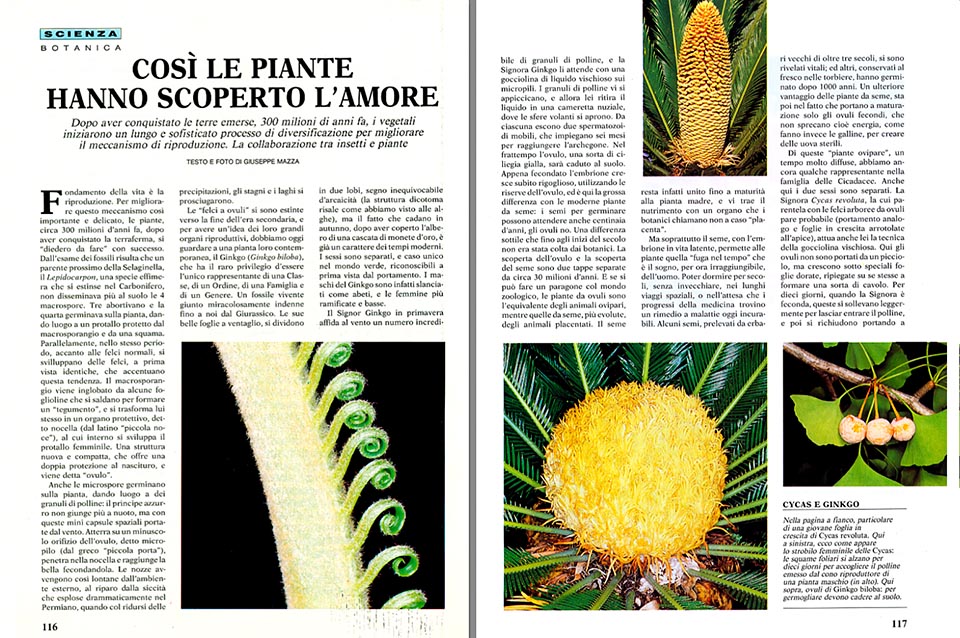
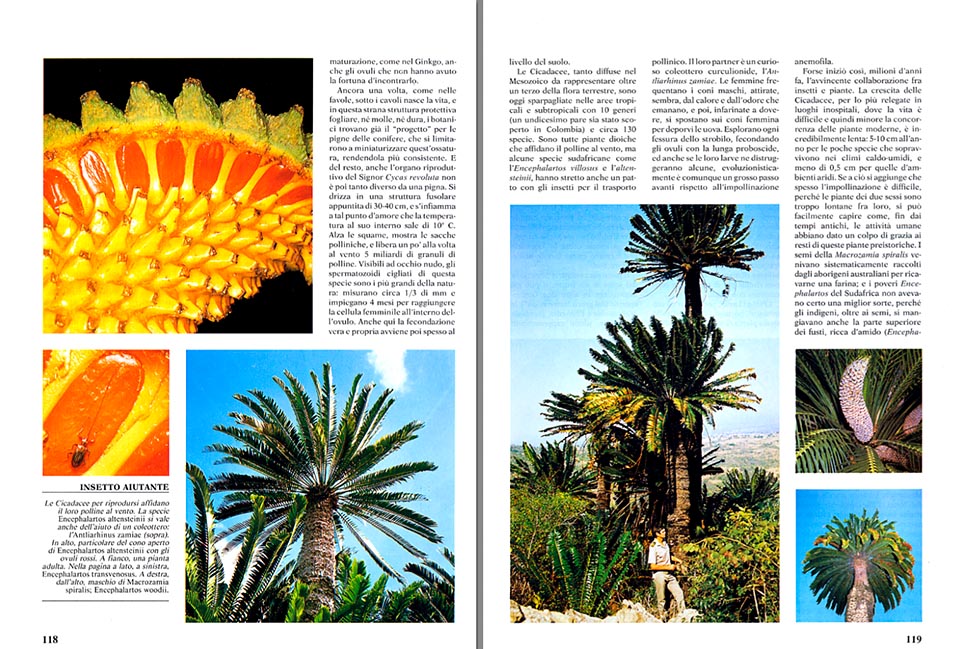
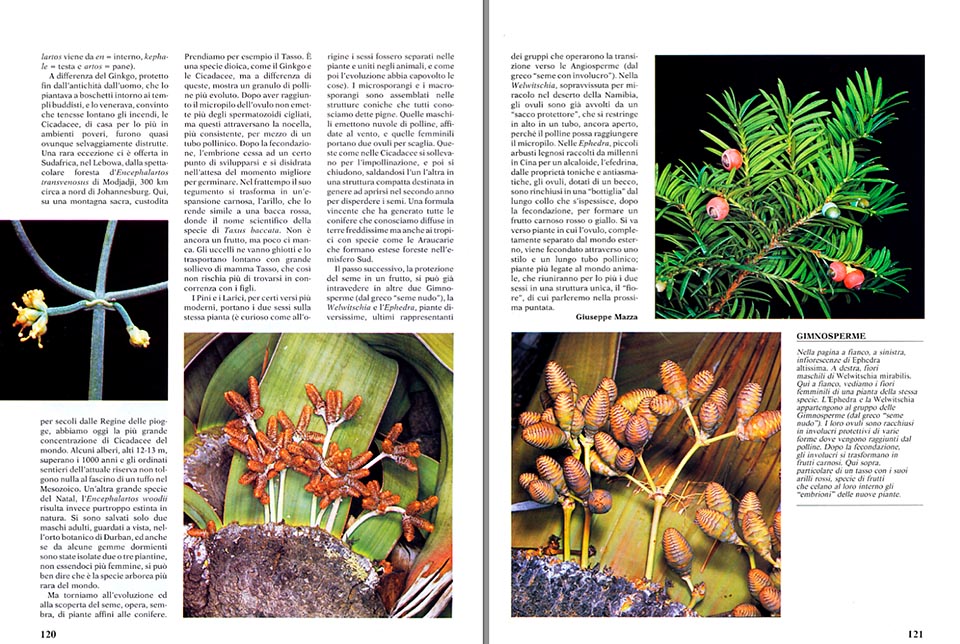

Texto © Giuseppe Mazza

English translation by Mario Beltramini
One of the major aces of nature evolution is the protection of infancy; and after having reached the main land, and having invented the leaves and the wood, about 300 million of years ago, the plants made a change of quality towards this direction.
From the examination of fossils, it comes out that a close relative to the Selaginella, the Lepidocarpon, an ephemeral species which extinguished in the Carboniferous, was not any more disseminating on the ground the four macrospores. Three were aborting and the fourth was germinating on the plant, giving rise to a prothallus, protected by the megasporangium and by a squama.
In like manner, in the same period, close to normal ferns, others develop, identical at first sight, which stree this tendency. The macrosporangium is consolidated by some small leaves which join, thus forming an integument, which, itself, transforms in a protective organ, called “nucellus” (from the Latin “little nut”), in the interior of which develops the feminine prothallium. A new and solid structure, which offers a double protection to the future baby, and is called “ovule”.
Also the microspores germinate on the plant, generating granules of “pollen”, and the Prince Charming does not come any more by swimming, but with these mini-capsules carried by the wind.
It lands in a small opening of the ovule, called “micropyle” (from the Greek “little door”), penetrates the nucellus and reaches the belle, fecundating her. Thus, marriage happens far away from the external environment, safe from the drought which dramatically exploded in the Permian, when, due to the reduction of precipitations, the ponds and the lakes dried up.
The “ovular ferns” have extinguished by the end of the Secondary, and, in order to get an idea of these large reproductive organs, we must nowadays look at a plant which is their contemporaneous, the Ginkgo (Ginkgo biloba), which has the rare privilege of being the sole representative of a Class, an Order, a Family, and a Genus. A “living fossil”, which has come to us, miraculously unhurt, from the Jurassic.
Its nice fan-like leaves, divided in two lobes, unequivocal sign of archaism (the dichotomous structure goes back, as we have seen, to the algae), but the fact that they fall in autumn, after having covered the tree with a cascade of gold coins, is already a character of modern times. Sexes are separated, and, unique instance in the Green World, can be recognized at first sight by their gait. The males of Ginkgo are, in fact, slender like fir-trees, and the females are more ramified and low.
In springtime, Mr Ginkgo entrusts the wind an incredible quantity of granules of pollen, and Mrs. Ginkgo waits for them with a small drop of viscous liquid on the micropyles. The granules of pollen stick there, and then she takes back the liquid into a small nuptial chamber, where the flying spheres open. From each one, two mobile spermatozoa come out, and will employ six months to reach the archegonium. In the meantime, the ovule, a sort of yellow cherry, will fall to the ground.
As soon as fecundated, the embryo grows up, luxuriant, utilizing the reserves of the ovule, and here stands the huge difference with the modern seed plants: the seeds can wait even hundreds of years for germinating, the ovules can’t. A thin difference that till the beginning of the century had not been detected by the botanists.
The discovery of the ovule and that of the seed are two stages separated by about 30 millions of years.
And, if we can do a comparison with the zoological world, the ovule plants are the equivalent of the oviparous animals, whilst the seed ones, more evolved, of the placental animals. The seed, in fact, remains united to the mother plant till when ripe, and draws from it the nourishment with an organ called by botanists, and not by chance, “placenta”. But especially the seed, with the embryo in dormant life, grants the plants that “escape in the time”, which is the dream, for the moment unachievable, of mankind. To be able to sleep for centuries, without getting old, during the long space voyages, or while waiting for the progress of medicine to find a remedy against till now incurable diseases.
Some seeds, taken off from more than three century old herbaria, have proved to be vital; a,d others, preserved in the coolness in peat-bogs, have germinated after 1.000 years. A further advantage of the seed plants, stands then in the fact that they carry to ripening only fecund ovules, which therefore, do not waste energy, like the hens, to create sterile eggs.
Of these “oviparous plants”, once very common, we have still some representatives in the family of the Cycadaceae. Also here, the two sexes are separated.
Mrs. Cycas revoluta, the relationship of which with the arboreal ovule ferns looks likely (analogous gait and growing leaves curled at the apex), acts, she too, the technique of the viscous small drop. Here the ovules are not carried by a petiole, but grow up under special golden leaves, folded on themselves, forming a sort of a cabbage. For ten days, when the Lady is fecund, these ones rise slightly allowing the pollen to enter, and then close carrying to ripening, as for the Ginkgo, also the ovules which have not had the chance to meet it.
Once more, as in the tales, life comes out from under cabbages, and in this strange protective foliar structure, neither tender, nor hard, botanists find already the “project” for the pine-cones of the conifers, which limited themselves to minimize this framework, rendering same more consistent.
And, besides, also the sex of Mr. Cycas revoluta is not very different from a pine-cone. It stands up in a straight, sharp structure of 30-40 cm., and gets so much excited that the temperature, inside, increases of 10°C. It raises the squamae, exhibits the pollinating bags, and frees slowly to the wind 5 billions of granules of pollen.
Visible to naked eye, the ciliated spermatozoa of this species are the largest in nature: they are bout 1/3 of mm. long, and employ four months to reach the feminine cell inside the ovule. Also here, the real fecundation often takes place on the ground.
The Cycadaceae, so much diffused in the Mesozoic to represent more than one third of the terrestrial flora, are nowadays spread around in the tropical and subtropical areas with 10 genera (an eleventh seems having been discovered in Colombia), and about 130 species. They are all dioicous plants which entrust the pollen to the wind, but some South African species, such as the Encephalartos villosus and the Encephalartos altensteinii, have reached an agreement with the insects for the transportation of the pollen.
Their partner is an odd curculionid weevil, the Antliarhinus zamiae. The females frequent the masculine cones, attracted, it seems, by the heath and the scent they exhale, and then, duly powdered, move to the feminine ones, to lay the eggs. They explore each fissure of the strobile, fecundating the ovules with a long trunk, and even if the larvae will destroy some of them, evolutionally, it’s however a huge step ahead in comparison with the aneophilous pollination. Maybe, millions of years ago, the fascinating collaboration between insects and plants started in this way.
The growth of the Cycadaceae, mostly confined in inhospitable areas, where life is difficult and thence, minor is the competition of modern plants, is incredibly slow: 5-10 cm. per year for the few species which survive in the hot-humid climates, and less than 0,5 cm. for those in the arid habitats. If to this, we add that often the pollination is not easy, because the plants of the two sexes are too much distant each other, we can easily understand how, since the old times, the human activities have given the finishing stroke to the remains of these prehistoric plants.
The seeds of the Macrozamia spiralis were systematically collected by the Australian aborigines, to get a flour; and the miser Encephalartos of South Africa had not, by sure, a better life, as the natives, beyond the seeds, were eating also the upper part of the stems, rich of starch (Encephalartos comes from EN=internal, KEPHALE=head, and ARTOS=bread).
Unlike Ginkgo, protected since the old times by men, who planted it in thickets around the Buddhist temples, and did venerate it, convinced that it kept away the fires, the Cycadaceae, mostly familiar with poor habitats, were almost everywhere wildly destroyed.
A rare exception is given to us in South Africa, in the Lebowia, by the spectacular forest of Encephalartos transvenosus of Modjadji, about 300 Km. north of Johannesburg. Here, on a holy mountain, guarded for centuries by the Queen of rains, we have today the biggest concentration of Cycadaceae in the world. Some trees, 12-13 metres tall, overcome the 1.000 years and the tidy paths of the present reserve do not spoil at all the fascination of a dive into the Mesozoic.
Another big species in Natal, the Encephalartos woodii, appears, on the contrary, unluckily, to be extinct in the wild. Only two male adults do survive, closely watched, in the botanic orchard of Durban, and even if they have isolated two or three small plants from some sleeping cells, as there are no more females, we can well say that this is the most rare arboreal species in the world.
But let’s go back to the evolution and to the discovery, made by plants close to the conifers, of the seed.
Let us consider the Yew. It’s a dioicous species, like the Ginkgo and the Cycadaceae, but, unlike these ones, it shows a more developed granule of pollen. After having reached the micropyle of the ovule, it does not any more emit ciliated spermatozoa, but these cross the nucellus, more consistent, by means of a “pollinating tube”. After fecundation , the embryo, at a certain moment, stops to develop and dehydrates, awaiting the best time for germinating. In the meantime, its tegument transforms in a fleshy expansion, the aril, which makes it similar to a red berry, from where comes the scientific name of Taxus baccata.
It is not yet a fruit, but it’s very close to that. Birds are very greedy of that, and carry it far away with great relief of mother Yew, which will not risk to get in competition with the offspring.
The Pines and the Larches, for some things more modern, carry the two sexes on the same plant (it’s bizarre how at the origin the sexes were separated in the plants and united in animals, and how then the evolution has inverted the thing!). The microsporangia and the macrosporangia are assembled in the conical structures that we all know as pine-cones.
The masculine ones emit clouds of pollen, entrusted to the wind, and the feminine ones carry two ovules for each scale. These ones, as for the Cycadaceae, arise for the pollination, and then close, joining each other in a compact structure, meant, generally, to open on the second year, to release the seeds.
A winning formula, which has generated all the conifers we know, spread in very cold areas, but also in the Tropics, with species such as the Araucaria, which form wide forests in the Austral hemisphere.
The next step, the protection of the seed in a fruit, can be already seen, even if indistinctly, in two other Gymnosperms (from the Greek “naked seed”), the Welwitschia and the Ephedra, quite different plants, last specimen of the groups which have effected the transition towards the Angiosperms (from the Greek “seed in a receptacle”).
In the Weltwischia, miraculously survived in the desert of Namibia (see the specific article published on SCIENZA & VITA), the ovules are already entangled in a “protecting sack”, which narrows in the upper side, becoming a tube, still open, so that, the pollen can reach the micropyle.
In the Ephedra, small woody shrubs, picked up in China since millennia, for an alkaloid, the ephedrine, with a tonic and anti-asthmatic properties, the ovules, provided with a beak, are enclosed in a “bottle”, with a long neck, which gets thick, after the fecundation, thus forming a fleshy red or yellow fruit.
We are proceeding towards plants where the ovule, completely separated from the outer world, is fecundated through a style and a long pollinating tube; plants closer to the animal world, which will almost all put together the two sexes in only one structure, the “flower”, of which we shall treat in the next instalment.
When plants created the flower
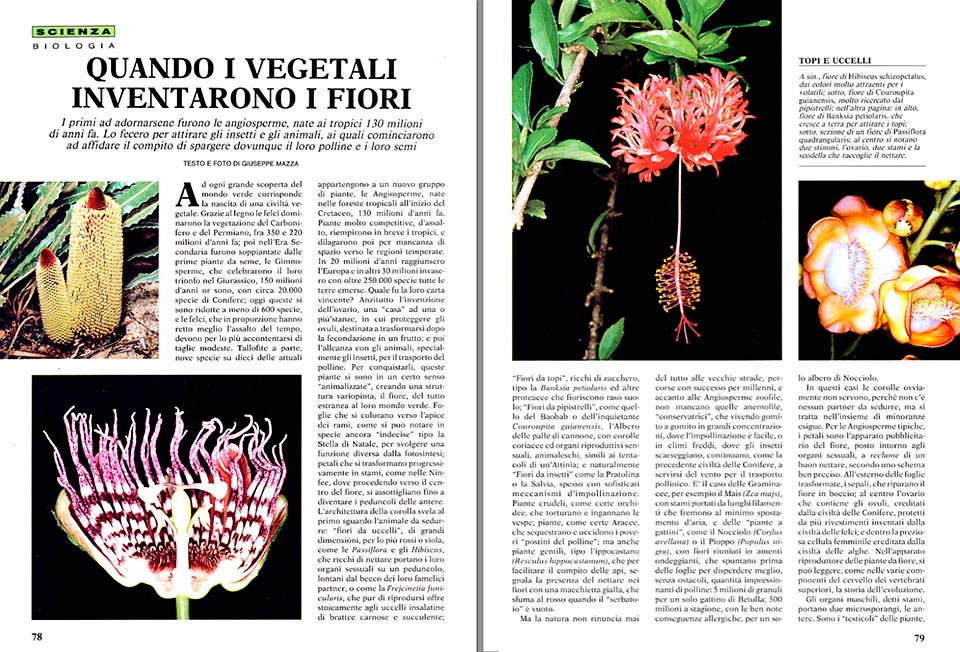
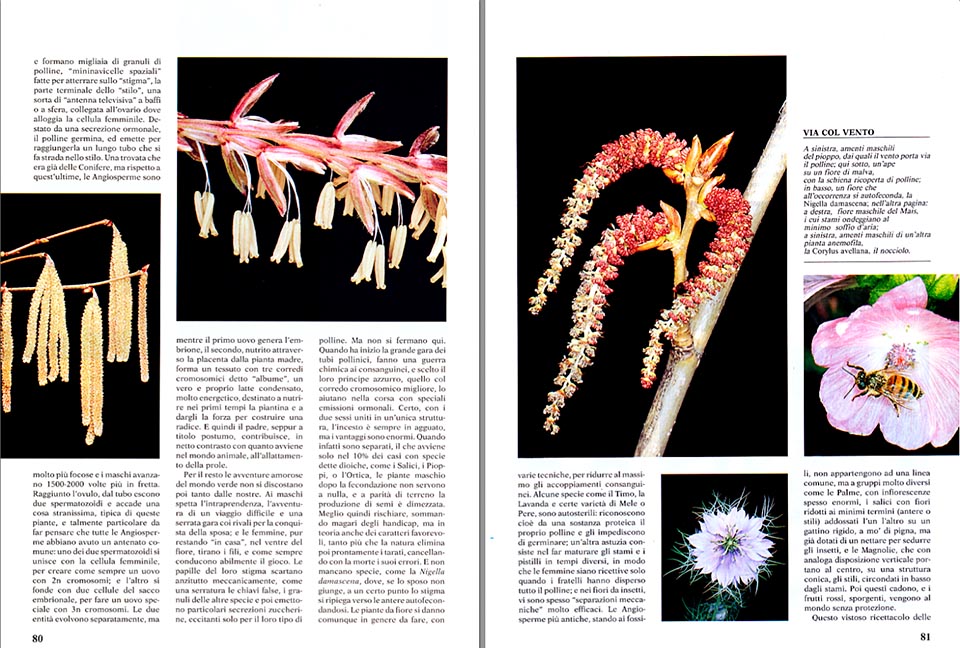
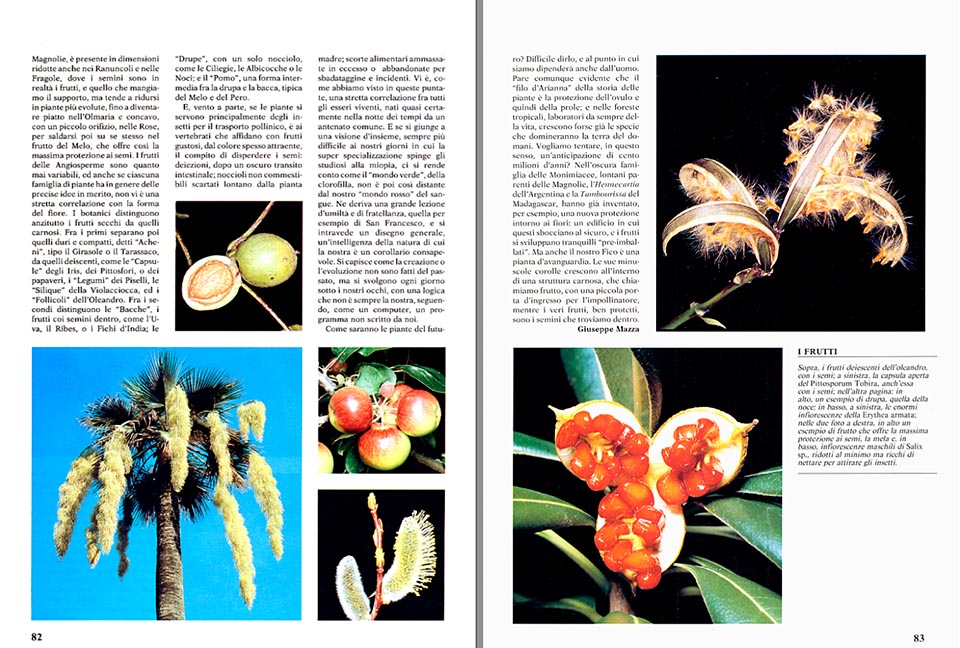

Texto © Giuseppe Mazza

English translation by Mario Beltramini
To each great discovery of the Green World, corresponds the birth of a vegetable civilization.
Thanks to the wood, the ferns dominated the vegetation of the Carboniferous and the Permian, between 350 and 220 millions of year ago, then in the Secondary era, they were ousted by the first seed plants, the Gymnosperms, which celebrated their triumph in the Jurassic, 150 millions of years ago, with about 20.000 species of Conifers; nowadays they have reduced to less than 600 species, and the ferns, which proportionally have supported better the attacks of time, must, at the most, contempt of more modest sizes.
Apart the Thallophytes, nine of ten of present species belong to a new group of plants, the Angiosperms, born in the tropical forests, by the beginning of the Cretaceous, 130 millions of years ago.
Very competitive plants, warlike, they did fill up, in short time, the Tropics, and then, lacking of room, spread towards the temperate regions. In 20 millions of years, they reached Europe, and in 30 millions more, they invaded all emerged lands with 250.000 species.
Which was their winning card?
First of all, the invention of the ovary, a “house”, with one or more rooms, where to protect the ovules, meant to transform, after the fecundation, in a fruit; and then, the alliance with animals, especially the insects, for the transportation of pollen.
In order to conquer them, these plants have, in a certain way, “animalized” themselves, creating a many-coloured structure, the flower, completely extraneous to their Green World.
Leaves which colour towards the apex of the branches, as we can notice in species still “undecided”, like the Christmas star, to carry out a function different from the photosynthesis; petals which progressively transform in stamens, like the Water-lilies, where, proceeding towards the centre of the flower, they reduce to become the peduncles of the anthers.
The architecture of the corolla reveals at sight the animal to be seduced: “Flowers for birds”, of large size, mainly red or violet, like the Passiflora and the Hibiscus, which, rich of nectar, carry their sexual organs on a peduncle, away from the beak of their ravenous partners, or like the Freycinetia funicularis, which, if only to reproduce, offers, stoically, the birds small salads of bracts, fleshy and juicy; “Flowers for mice”, rich of sugar, such as the Banksia petiolaris and other Proteaceae, which bloom close to the ground; “Flowers for bats”, like those of the Baobab or of the disturbing Couroupita guianensis, the Cannon ball Tree, with leathery corollas and sensuous, animal, reproductive organs, similar to the tentacles of a Sea anemone; and, of course, “Flowers for insects”, such as the Lawn Daisy, or the Sage, often with sophisticated means of pollination.
Cruel plants, like some orchids, which torture and cheat the wasps; plants like certain Arums, which kidnap and kill the miser “pollen carriers”; but also gentle ones, such as the Horse-chestnut (Aesculus hippocastanum), which, to simplify the task of the bees, marks the presence of nectar in the flowers, with a small yellow dot, which turns to red when the “reservoir” is empty.
But nature never abandons completely the old methods, which have been travelled, successfully, for millennia, and close to the zoophile Angiosperms, are not missing those anemophilous, “conservative”, which, living side by side in huge concentrations where pollination is easy, go on, like the previous civilization of the Conifers, to make use of the wind for carrying the pollen.
It is the case of the Gramineae, for instance, the Maize (Zea mays), with stamens carried by long filaments which quiver, at the least movement of air, and of the “catkin plants”, such as the Hazel (Corylus avellana), or the Poplar (Populus nigra), with flowers assembled in waving amenta, which sprout before the leaves, in order to better disperse, without hindrances, impressive quantities of pollen, 5 millions of granules for just one Birch catkin; 500 millions per season, with the well known allergic consequences, for a single tree of Hazel.
In these cases, obviously, the corollas are of no use, also because there are no partners at all to seduce, but it is matter, in the whole, of exiguous minorities.
For the typical Angiosperms, the petals are the publicity apparatus of the flower, placed around the sexual organs, advertising a good nectar, following a well definite scheme. Out of the transformed leaves, the sepals, which give shelter to the flower in bud; at the centre the ovary which contains the ovules, inherited from the civilization of the Conifers, protected by various coverings invented by the civilization of ferns; and, inside, the precious feminine cell inherited from the civilization of the algae. In the reproducing apparatus of the flower plants, we can read, like in the various components of the brain of superior vertebrates, the history of evolution.
The masculine organs, called stamens, carry two microsporangia, the anthers. They are the “testicles” of the plants, and form thousands of granules of pollen, “mini space ships”, done for landing on the “stigma”, the terminal part of the “style”, a sort of directional or satellite “TV antenna”, connected to the ovary where the feminine cell is lodged.
Awoken by a hormonal secretion, the pollen germinates, and sends forth, to reach it, a long “tube”, which makes its way into the style. An expedient which already belonged to the Conifers, but as regards these last ones, the Angiosperms are much more passionate, and the males advance 1.500 – 2.000 times faster.
Reached the ovule, from the tube get out two spermatozoids and it happens a very odd things, typical of these plants, and so much particular to lead to think that all the Angiosperms have had a common ancestor: one of the two spermatozoids joins a feminine cell, to create, as always, an egg with 2n chromosomes; and the other melts with two cells of the embryonic bag, to make a special egg, with 3n chromosomes. The two entities evolve separately, but while the first egg generates the embryo, the second, fed through the placenta by the mother plant, forms a tissue with three chromosome outfits, , called “albumen”, areal and true condensed milk, very tonic, intended for feeding, during the first times, the small plant and give the energy for building up a root.
And, therefore, the father, even if posthumously, contributes, in clear contrast with what happens in the animal world, to the nursing of the offspring.
For the rest, the amatory adventures of the Green World, do not differ, then, too much from ours. To the males is due the initiative, the adventure of a difficult voyage, and a hard competition with the rivals for the conquest of the bride; and the females, even if remaining “at home”, in the belly of the flower, draw the threads, and, as always, lead, skilfully, the game.
The papillae of their stigma reject, first of all, spontaneously, like does a lock with the false key, the granules of the other species, and then eject particular sugary secretions, exciting only for their type of pollen. But they do not stop here. When the great race of the polliniferous tubes begins, they make a chemical war against the kinsmen, and, chosen their Prince Charming, the one with the best chromosome equipment, they help it in the race with special hormonal emissions.
By sure, with the two sexes united in a same structure, the incest is always in ambush, but the advantages are enormous. When, in fact, they are separated, which happens only in the 10% of the cases, with species called “dioicous”, such as the Willow-trees, the Poplars, or the Stinging-nettle, the masculine plants after the fecundation are of no use, and, at a parity of soil, the production of seeds is halved.
Better, then, to risk, summing up even some handicaps, but in theory also some favourable characters, seen that the nature then eliminates quickly those with defects, wiping out, by the death, its errors.
And there are species, such as the Nigella damascena, where, if the bridegroom does not come, at a certain point the stigma bends towards the anthers, auto fecundating.
The flower plants, anyway, are very active, through various techniques, to reduce at the maximum the consanguineous pairing. Some species, such as the Thyme, the Lavender, and some varieties of Apples or Pears, are self-sterile; they recognize, in fact, from a protein substance, their own pollen, and do not allow it to germinate; another ruse consists to get stamens and pistils to ripe at different times, so that females are receptive only when their brothers have dispersed all the pollens; and in the insect flowers, there are, often, very efficient “mechanical separations”.
The most ancient Angiosperms, after the fossils, do not belong to a common line, but to very different groups, such as the Palms, with often enormous inflorescences, the Willows, with flowers reduced to the smallest sizes (anthers or styles), crowded one on the other on a rigid ament, like a cone, but already provided with a nectar to seduce the insects, and the Magnolias, which, with a similar vertical disposition, carry, in the centre, on a conical structure, the styles, surrounded, on the bottom, by the stamens. Then, these ones fall down, and the protruding red fruits come out, without any protection.
This showy receptacle of the Magnolias, is present, on a reduced scale, also in the Buttercups, and the Strawberries, where the “little seeds”, are, actually, the fruits, and what we eat, the support, but it tends to reduce in the more developed plants, until it becomes flat in the Meadowsweet, and concave, with a small orifice, in the Roses, to finally close on itself in the fruit of the Apple tree, which offers, in this way, the maximum protection to the seeds.
The fruits of the Angiosperms, are very much variable, and even if each family of plants has generally precise ideas about this, there is not a close correlation with the shape of the flower.
Botanists make the difference, first of all, between dry and pulpy fruits.
In the first ones, they then separate the hard from the compact ones, called “Achenes”, like the Sunflower of the Dandelion, from the “dehiscent”, such as the “Capsules”, of the Iris, the Pittosporum, or the Poppy, the “Legumes”, of the Peas, the “Siliques”, of the Stocks, and the “Follicles”, of the Oleander.
Among the second ones, the distinguish the “Berries”, the fruits with the small seeds inside, such as the grape, the Ribes, the Indian Fig Opuntia; the “Drupes”, with a unique stone, such as the cherries, the apricots or the nuts; and the “Pommel”, an intermediate form between the drupe and the berry, typical of the Apple tree and of the Pear tree.
And, apart the wind, if the plants mainly utilize the insects for the transportation of the pollen, it is to the vertebrates that they entrust, with tasty fruits, with often attractive colours, the task to disperse the seeds: dejection after an obscure intestinal transit; non edible stones rejected far away from the mother plant; provisions collected in excess or abandoned for inadvertency and incidents.
There is, as we have seen during these instalments, a close correlation between all living beings, born almost certainly, in the night of the times, from the same ancestor.
And, if we get to an overall vision, always more difficult in our days, where the super specialization pushes the students to the “short-sightedness”, up to the point of “knowing everything of nothing”, we realize how the “Green World” of the chlorophyll is not so distant from our “Red World”, of the blood.
It results then, a great lesson of humility and brotherhood, the one, for instance, of St. Francis, and we can catch a glimpse of a general design, an intelligence of the nature of which ours is a conscious corollary.
We can then understand how the creation or the evolution are not events of the past, but they take place every day under our eyes, with a logic which is not always ours, following, like a computer, a “program”, which was not written by us.
How will be the future plants alike? It is difficult to say, and, as matters stand, it will depend also from mankind. It seems, however, evident that the “Ariadne’s thread” of the history of plants is the protection of the ovule and, consequently, of the offspring; and the species which will dominate tomorrow’s earth are, perhaps, already growing in the tropical forests, laboratories, since always, of the life.
Can we try, in this way, a one hundred million years anticipation?
In the obscure family of the Monimiaceae, remote relatives to Magnolias, the Hennecartia of Argentina, and the Tambourissa of Madagascar, have already invented, for instance, a new protection around the flowers: a construction where these ones bloom safely, and the fruits develop in peace, “pre-packaged”. But, also our Fig is a plant in the van. Its small corollas grow up inside a fleshy structure, which we call “fruit”, with a small entry door for the pollinator, while the real fruits, well protected, are the “small seeds”, which we find inside.
SCIENZA & VITA NATURA – 1992
